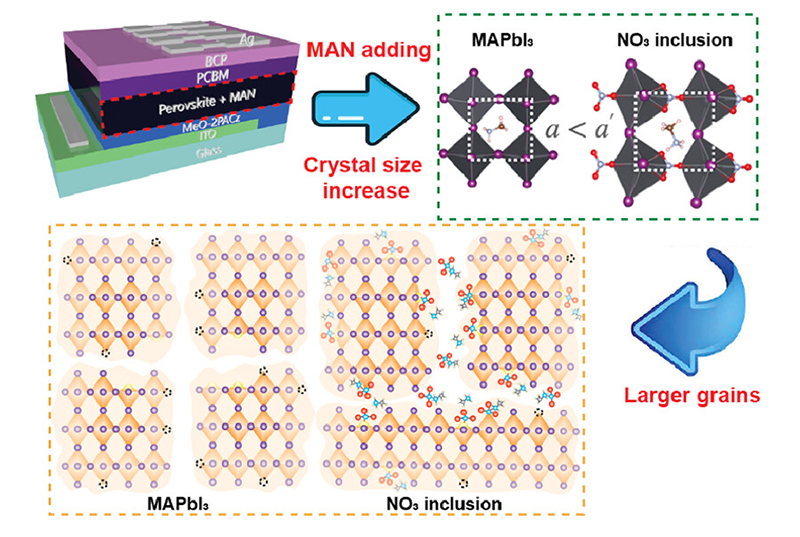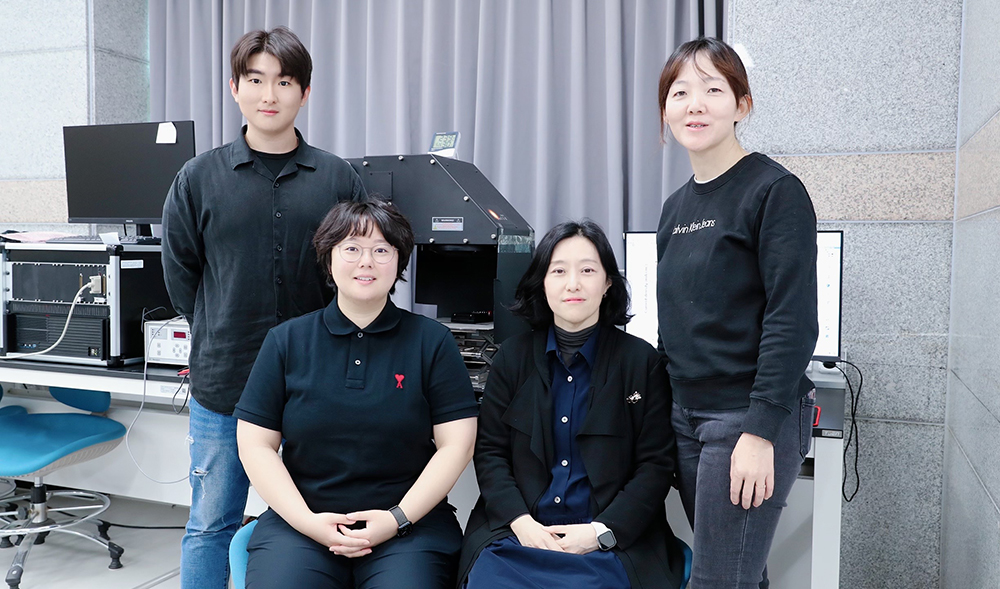- 게시일자
- 조회수
- 576
[PNU리서치] 서지연·김효정 교수팀, 온도감응형 첨가제로 페로브스카이트 결정 성장 조절해
나노에너지공학과 서지연 교수팀과 유기소재시스템공학과 김효정 교수팀은 스위스 로잔 연방 공과대학교(EPFL) 마이클 그라첼 교수와의 국제공동연구를 통해 소량의 첨가제로 페로브스카이트 결정립 성장을 조절함과 동시에 결함을 패시베이션함으로써 페로브스카이트 태양전지의 효율 및 열 안정성을 향상시킬 수 있음을 규명했다.
* 페로브스카이트 태양전지(Perovskite Solar Cells): 유·무기 혼합 페로브스카이트 결정구조를 광흡수층으로 활용하는 박막형 태양전지. ‘페로브스카이트(perovskite)’는 ABX₃구조를 갖는 대부분의 물질을 칭함.
‘페로브스카이트 태양전지(PSCs)’는 높은 효율과 낮은 비용으로 인해 차세대 태양전지의 유망한 후보로 부상했다. 이번 연구에서 서지연 교수팀과 김효정 교수팀은 온도 감응형 첨가제 엔지니어링을 활용해 결정성장 조절 기술과 태양전지 안정성을 확보하는 데 성공했다.
첨가제 엔지니어링은 오랫동안 PSCs의 성능을 향상시키기 위한 핵심 전략으로 인식돼 왔다. 제1저자로 참여한 나노융합기술학과 김선주 박사과정생은 소량의 CH3NH3+NO3- (Methylammonium Nirtate, MAN)을 페로브스카이트 전구체 용액에 도입해 결정립 성장을 조절하고 결정립계의 아이오딘 빈자리를 대체함으로써 페로브스카이트 활성층의 태양광 특성을 성공적으로 개선했다.
유기소재시스템공학과 김효정 교수와 공동 제1저자인 나노반도체공정·장비계약학과 조인화 연구교수는 ab initio 계산과 함께 in situ XRD 및 UV-visible 분광을 포함한 심층 분석을 통해 MAN 첨가제를 사용한 PSCs의 향상된 성능 및 안정성의 기초가 되는 메커니즘을 밝혀냈다. 이러한 발견은 온도에 민감한 첨가제 엔지니어링이 효율적이고 내구성이 뛰어난 PSCs 기술 개발을 촉진할 수있는 가능성을 강조한다.

【페로브스카이트 결정립 경계에서의 첨가제 거동 및 역할】
첨가제의 온도 민감성에 대한 추가적인 통찰은 다양한 기후, 특히 온도가 상승된 지역에서 PSCs의 성능 및 안정성을 향상시키는 데에 있어 귀중한 개발 방향성을 제공했다. 이 획기적인 연구는 지속 가능하고 신뢰할 수 있는 재생 가능한 에너지원을 찾는 데 중요한 진전을 의미한다. 연구팀은 온도에 민감한 첨가제 공학의 힘을 활용해 페로브스카이트 태양전지를 통해 더 밝고 친환경적인 미래를 향해 길을 열고 있다.
나노에너지공학과 서지연 교수는 “이번 연구 결과는 첨가제들이 고온에서 페로브스카이트 태양전지 결정 내에서 어떠한 기능을 하는지 메커니즘을 최초로 규명한 것”이라며 “향후 페로브스카이트 태양전지가 옥외에 사용될 때 고온 환경에서도 안정하게 작동할 수 있는 기술로 상용화되는 데 기여할 수 있다”고 말했다.
해당 논문은 국제 학술지 『ACS Energy LETTERS』 4월 12일자에 게재됐다.
- 논문 제목: Methylammonium Nitrate-Mediated Crystal Growth and Defect Passivation in Lead Halide Perovskite Solar Cells(질산메틸암모늄을 매개로 한 페로브스카이트 태양전지에서의 결정 성장과 결함 패시베이션)
- 논문 링크: https://doi.org/10.1021/acsenergylett.4c00154
이번 연구는 교육부가 지원하는 한국연구재단의 기초과학연구 프로그램 지원과 산업통상자원부와 한국기술진흥원의 국제협력연구개발 프로그램을 통해 재정지원을 받았다.
* 인물 사진: 왼쪽부터 (아래) 서지연 교수, 김효정 교수, (위) 김선주 박사과정생, 조인화 연구교수.
[Abstract]
Additive engineering has been a crucial strategy to improve photovoltaic properties by reducing carrier trap centers or increasing carrier diffusion lengths in the lead halide perovskite active layer. We introduced a small amount of CH3NH3+NO3- (methylammonium nitrate, MAN) to a pristine MAPbl3 precursor solution as an agent for controlling the grain growth rate and healing iodine vacancies at grain boundaries of a perovskite film. With an addition of MAN, the larger grains were formed, confirmed by surface morphology images, and higher environmental stability was evidenced by in situ impedance spectroscopy results. For the optimized sample with an addition of 0.3 mol % MAN, high power conversion efficiency (PCE) of 20.5% (18.7% for the pristine sample) was successively demonstrated. In addition, the remnant NO3 ions were identified at the perovskite grain boundaries at room temperature and inside the unit cell at high temperature, as evidenced by results of in situ X-ray diffraction and in situ UV?visible spectroscopy measurements. Temperature dependence behaviors of the additive provide an in-depth understanding for designing and selecting additives to increase the PCE and stability of the perovskite solar cells.
* Reference
- Authors (Pusan National University):
· First author: Sun-Ju Kim (Department of Nano Fusion Technology), In Hwa Cho (Semiconductor Process and Equipment Contract Department)
· Corresponding authors: Prof. Hyo Jung Kim (School of Chemical Engineering), Prof. Ji-Youn Seo (Department of Nano Fusion Technology)
- Title of original paper: Methylammonium Nitrate-Mediated Crystal Growth and Defect Passivation in Lead Halide Perovskite Solar Cells
- https://doi.org/10.1021/acsenergylett.4c00154
- Journal: ACS Energy Letters
- 첨부파일
- 첨부파일이(가) 없습니다.
